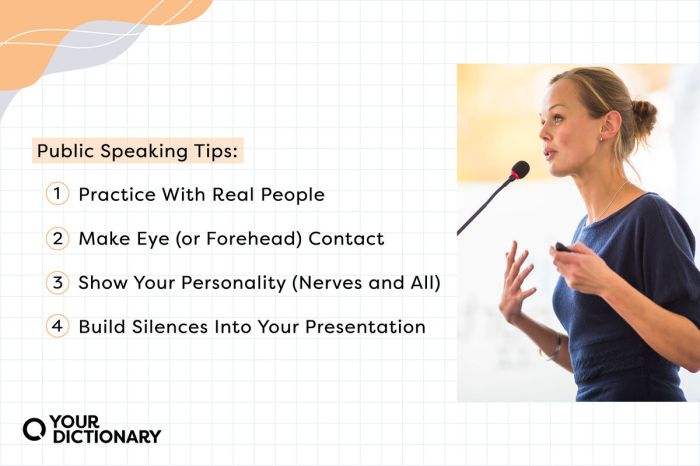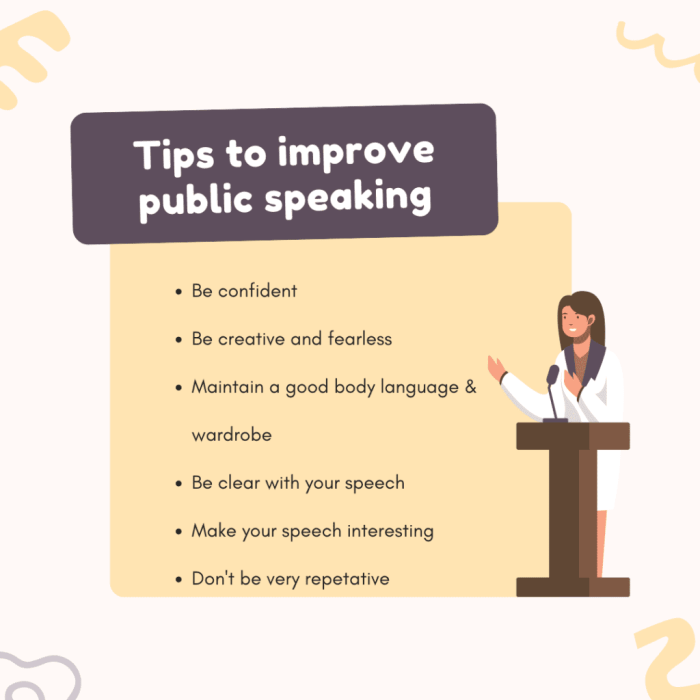Public Speaking Tips: Whether you’re addressing a crowd or presenting in class, mastering the art of effective communication is crucial for success. From overcoming stage fright to structuring your speech, this guide covers everything you need to know to become a confident and engaging speaker.
Are you ready to elevate your public speaking skills to the next level? Let’s dive in!
Introduction to Public Speaking

Public speaking is the art of delivering a message to an audience. It is an essential skill that can help individuals communicate effectively, share ideas, and inspire others. Improving public speaking abilities can lead to increased confidence, better career opportunities, and stronger connections with people.
Importance of Public Speaking
- Public speaking is necessary in professional settings such as presentations, meetings, and job interviews.
- It is crucial for students giving class presentations or participating in debates.
- In social situations, public speaking skills can help individuals express themselves clearly and persuasively.
Benefits of Improving Public Speaking Skills
- Enhanced communication skills that can lead to better relationships and networking opportunities.
- Increased confidence in expressing ideas and opinions in various settings.
- Career advancement as strong public speaking skills are valued in many professions.
Overcoming Fear of Public Speaking

Public speaking can be nerve-wracking for many people, but there are strategies you can use to manage anxiety and boost your confidence before addressing an audience.
Strategies for Managing Anxiety
- Practice deep breathing exercises to calm your nerves before speaking.
- Visualize yourself giving a successful speech to boost your confidence.
- Avoid caffeine and sugar before speaking, as they can increase feelings of anxiety.
Tips for Boosting Confidence
- Prepare and practice your speech thoroughly to feel more confident in your delivery.
- Maintain good posture and make eye contact with your audience to appear more confident.
- Focus on the message you want to convey rather than worrying about what others think of you.
Importance of Practice
Practice is key to reducing the fear of public speaking. The more you practice, the more comfortable and confident you will become in front of an audience. Rehearse your speech multiple times, either alone or in front of a mirror, to familiarize yourself with the content and delivery.
Effective Communication Techniques
Effective communication goes beyond just words – it involves body language, eye contact, and vocal tone. Mastering these aspects can greatly enhance your public speaking skills.
Significance of Body Language
Body language plays a crucial role in public speaking as it can convey confidence, credibility, and engagement to the audience. Here are some key points to remember:
- Avoid crossing your arms, as it can signal defensiveness or closed-off behavior.
- Stand tall and maintain good posture to exude confidence and authority.
- Gestures can help emphasize your points, but be mindful of using them excessively or inappropriately.
Maintaining Eye Contact, Public Speaking Tips
Maintaining eye contact with the audience is essential for building a connection and keeping them engaged. Here are some tips to help you:
- Scan the room and make eye contact with different audience members to create a sense of inclusivity.
- Focus on individuals or small groups for a few seconds each to make the connection more personal.
- Avoid staring at one spot or looking over the heads of the audience, as it can make you appear disinterested or nervous.
Importance of Vocal Variety and Tone
Your vocal variety and tone can greatly impact how your message is received by the audience. Here’s why it’s crucial:
- Changing your pitch, volume, and pace can help maintain the audience’s interest and emphasize key points.
- Using a monotone voice can make your speech sound dull and unengaging, so practice varying your tone.
- Pay attention to your intonation and inflection to convey emotions and add depth to your delivery.
Structuring a Speech: Public Speaking Tips
When it comes to delivering a successful speech, having a well-structured presentation is key. A well-structured speech typically consists of three main components: the introduction, body, and conclusion. Each of these parts plays a crucial role in engaging the audience and effectively conveying your message.
Components of a Well-Structured Speech
- The Introduction: This is where you grab the audience’s attention and introduce the topic of your speech. It should be engaging, concise, and set the stage for what’s to come.
- The Body: The body of your speech is where you delve into the main points and supporting details of your topic. Make sure to organize your ideas logically and cohesively to keep the audience following along.
- The Conclusion: In the conclusion, you should summarize the key points of your speech and leave the audience with a lasting impression. It’s your final opportunity to drive home your message and make a lasting impact.
Tips for Organizing Thoughts and Ideas Cohesively
- Create an Artikel: Before you start writing your speech, Artikel the main points you want to cover in each section. This will help you stay organized and ensure a logical flow of ideas.
- Use transitions: Transition smoothly between different sections of your speech to help the audience follow along. This can be done through words, phrases, or visual aids.
- Stick to the main message: Make sure all your points and examples are relevant to the main message of your speech. Avoid going off on tangents that can confuse your audience.
Techniques for Engaging the Audience Throughout the Speech
- Ask questions: Encourage audience participation by asking thought-provoking questions related to your topic. This can help keep the audience engaged and make them feel involved.
- Use storytelling: Incorporate personal anecdotes or stories to make your speech more relatable and memorable. People are more likely to remember stories than facts and figures.
- Eye contact: Make eye contact with different audience members to establish a connection and maintain their attention. This shows that you are engaging directly with them.





